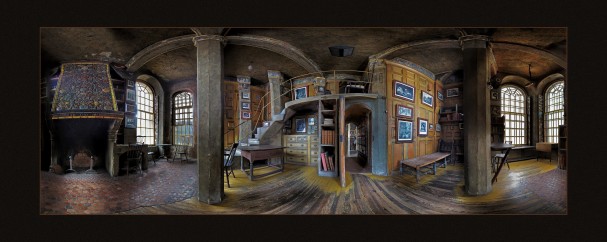Fonthill Castle in Doylestown, Pa., lends itself to photography because it’s a piece of artwork in and of itself. Built by Henry Chapman Mercer between 1908 and 1912, Fonthill Castle is built almost entirely of stone, cement and tiles, including artistic tiles with intricate designs and font work (thus Fonthill).
Now a museum, Fonthill Castle was designated a National Historic Landmark in 1985, and was a setting photographer Andrea Phox was itching to capture. Phox got her chance recently, and made the most of it, entering it in the Photo NorthEast competition and winning a Sunset Print Award in the process.
“I had never been there before, but I knew I wanted to go, so I went in with eight other photographers and rented it for three hours. It’s not a place you can shoot easily, and it has a lot of challenges from a lighting standpoint,” says Phox.
Phox shot this scene inside Fonthill Castle with a panoramic setup on top of a ball head, yielding 49 images stitched together using Autopano Pro.
“Using a ball head and the Really Right Stuff panoramic setup allows me to find the nodal point, or sweet spot, so I can capture a 360-degree panorama without parallax, which is a crossing over of the lines when they’re stitched together. I really try to get perfection in my images and I like to shoot 360s, but it is really difficult to capture those without a panoramic head,” explains Phox. “The lighting was all natural and it’s a 21mm to 33mm change of focal length during the panoramic. I put a very tiny aperture opening, f22, so that for the most part I was allowing that shutter to make its own decision. I put it on manual and rolled things around until it reached a nice middle point and then I would expose the images. Some images were two seconds and others were just under one second, depending on where my camera was pointed. The biggest challenge was the windows, and the severity in contrast between the windows and the room was very big. The fireplace inside is very dark, but I have information there. It’s all about detail for me.”
After capture, Phox says she first looks at the RAW files, stitches them together in Autopano Pro and then processed them through LightRoom, making the images smaller in the process.
“It’s a very digitally-complicated process and there’s no reason for me to have a panoramic that is 80″ x 40″ unless I want to print it out at that size,” says Phox.


